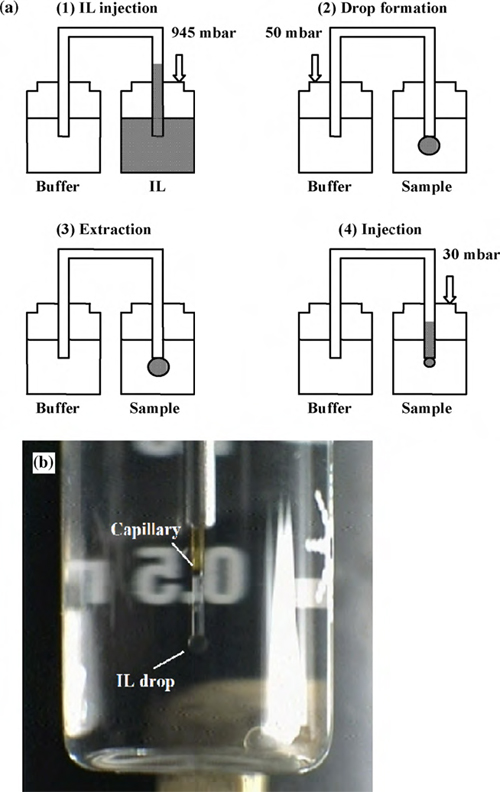Single-drop microextraction (SDME), as a kind of extraction form of liquid phase microextraction (LPME), has attracted considerable attention due to its low-cost but high sensitivity, rapidity and simplicity and has been off-line coupled with high-performance liquid chromatography (HPLC), gas chromatography (GC) and capillary electrophoresis (CE). However, in these studies, the whole process is performed manually so that imprecision, irreproducibility and inconvenience are inevitable.
CE is a rapidly growing analytical technique which has been widely used as a fast, powerful, and efficient analytical separation technique with low sample consumption and running cost. However, its applicability for the real sample analysis is limited on account of its low detection sensitivity. Hence, to improve the CE sensitivity, various methods have been developed prior to CE separation, such as solid phase microextraction (SPME), cloud point extraction (CPE), LPME. SDME, as its name advises, makes use of only microlitre of solvent for extracting analytes from aqueous samples. As a matter of fact, because of the characteristics of SDME, it is quite suitable to on-line couple with CE.Thus, the coupling between SDME and CE could be a useful technique for the determination of trace compounds.
In sample preconcentration, organic solvents have been commonly used for extractions. However, organic solvents may result in the environmental contamination and the poor reproducibility associated to their volatilization during the extraction process.Due to the good extractability of ionic liquids (ILs), ILs can be widely applied to extract compounds from aqueous solutions and usually provided good enrichment, reproducibility and limits of detection for analytes.
However, to the best of the researchers’ knowledge, the on-line coupling of IL-SDME and CE, which could be a useful tool for some analytical purposes, has not been described before.
Recently, researchers of the Key Laboratory of Chemistry of Northwestern Plant Resources of the CAS have established a novel IL-SDME–CE without any alteration of instrument which provides a rather rapid, simple and inexpensive method for the determination of phenols with sufficient sensitivity and reproducibility.
The work also demonstrates that IL is a promising solvent for SDME–CE since IL can suspend at the tip of the capillary much more stable and may provide higher selection and offer the possibility of determining the extracted analytes in a more reproducible way than common organic solvents. It is expected that, by using more tailored IL as extractant and extractaction processes with higher extraction efficiency and selectivity, IL based microextraction technique coupled with CE has potential application in biological analysis, drug analysis and other fields.

(a) Scheme of the IL-SDME-CE. (1) Injection of the IL, (2) IL single drop formation, (3) extraction of the target analytes in the aqueous solution into the IL phase, and (4) injection of the enriched IL phase into the capillary. (b) Image of an IL single drop hanging at the capillary tip.
The work was published in Journal of Chromatography A (Journal of Chromatography A, 1217 (2010) 5434–5439).
Abstract of the paper published in Journal of Chromatography A |

